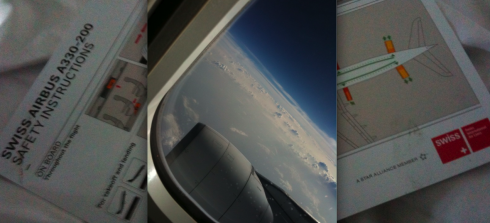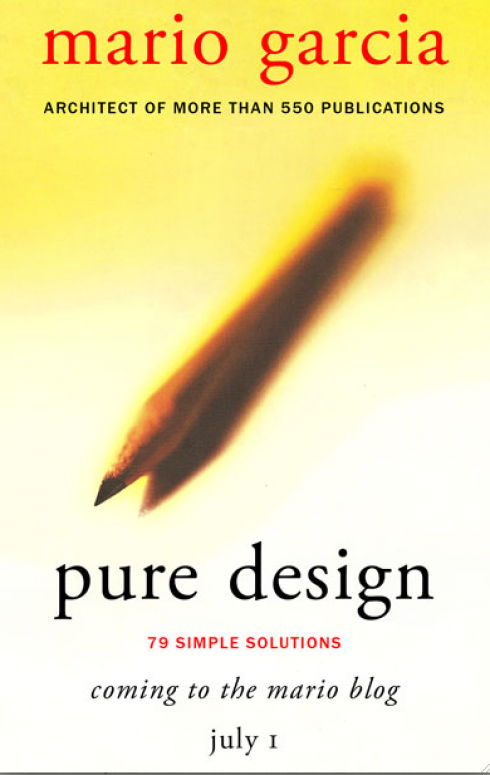Updated Wednesday, June 24, at 17:25 Nairobi local time

TAKEAWAY: A new book discusses the importance of simplicity in everything, from selling us a camera, an idea or a public policy. ALSO: Me afraid of flying? Not really, except on this Airbus 330.
Less is best, we always knew it
The title of his book is “In Pursuit of Elegance,” but author Matthew E. May makes a strong case for something we have always endorsed strongly: less is best.
May cites simplicity as the key to capturing our attention. To support his thesis, May tells about three ads for a Sony QV digital camera. The first gives details about every possible characteristic of the camera, the second simply mentions that the QV is a camera, and the third reveals nothing more that a new Sony product is coming.
The ad that got twice as much interest as the other two was the middle one: simply stating that the QV is a camera.
Tip: Important to remember, especially when we run into editors who insist on pouring the entire contents of a newspaper into a single page navigator full of details. To me, even the creation of a navigator should be based on some kind of logical explanation, starting with a sense of hierarchy. If our readers and users would have a chance to express how they feel about the products we produce for them, they will tell us:
Make it simple. Guide us in terms of importance. Limit what you include
Perhaps a better book title, and one waiting to be written, could be “The Power of Less”.
However, the power of less must be fueled by a heavy editing process. The best editors are those who can decide what is important and what is not, what is surprise and what is reaffirmation news; what is relevant as opposed to tired and trivial.
Yes, the subtitle for the book The Power of Less would be: One story that surprises worth 20 that reaffirm what we know.
From author Matthew E May’s blog:
I happen to think it’s not just a fun book to read, but a timely one. These are extremely difficult times for everyone. I’m optimistic that if we stop, slow down, think a bit more deeply and differently about the challenges we’re facing, the elegant solutions will begin to surface. The reason I think so is that I’ve been able to find many compelling examples from all over the world and from many disciplines that prove how a mindful approach to doing less, thinking more, and subtracting rather than adding, can lead to outcomes far outweighing what might be achieved using conventional approaches. In other words, when it comes to creative, innovative, resourceful, ideas that truly break through, I believe that what isn’t there can trump what is.
May’s comment on our blog entry about his book:
Mario, Thank you so much, I truly appreciate your thoughts! I will add you to my blogroll, follow on Twitter, and retweet yours, etc.
The interesting thing in all this is the attention being paid to the book by designers and thinkers like yourself! I was trying to get nondesigners to think more like designers,
not in a prescribed way, but thru stories and a light framework.
Fear of flying?

I did study the safety instructions card and even took a picture from my window when turbulence began over Africa
Thoughts while flying an Airbus 330-200 from Zurich to Nairobi:
From time to time someone asks me if I ever feel any fear of flying. Considering that I clock more than one million miles of flying per year—-and have kept that rhythm for over 25 years—-I am not likely to be one who thinks twice before getting on an aircraft as my preferred form of mobility.
However, I have to admit that the crash of Air France 447, an Airbus 330 which simply disappeared over the dark waters of the Atlantic en route from Rio to Paris, gives any traveler, including the most seasoned ones, a reason to just wonder: what happened? Can an aircraft simply disintegrate in the air and plunge to the depths of the ocean?
Of course, we still don’t know—-and may never know—-what caused AF 447 to end so tragically and mysteriously. The chances of finding those all-telling black boxes are getting to be fewer with each day that passes, and none at all after July 1, when the beeping sounds emitted by the boxes reach their 30-day limit.
Coincidentally, yesterday, as I sat in the Lufthansa lounge in Miami, waiting to board the flight to Frankfurt, CNN was reporting “an incident” on a Quantas Airbus 330, flying between Hong Kong and Perth, which encountered turbulence, injuring several passengers and crew.
Everyone is entitled to a little apprehension
Today, as I arrived in Zurich, to connect to my Swiss flight LX 292 to Nairobi, the first thing the lady at the Swiss Lounge mentioned in passing, when I asked about the location of my seat, was : “Well, sir, this is an Airbus 330……….”
I heard myself telling her: “Oh, I don’t want to hear that.”
She smiled and went on, business as usual, which I guess is how airline people react at the first signal that a passenger may be apprehensive about any aspect of airline safety, especially on today’s flight.
From the moment I got my boarding pass, until I boarded the Airbus 330, I was a little nervous about it all, a rare feeling for me. Everytime that aircraft made the most ordinary of noises, and, especially when it ran into a little turbulence as it flew near Athens, through that stretch of water that is the Adriatic Sea , I have to admit that I felt more than a bit uneasy. Yes, just plain nervous.
I wondered if Swiss has already replaced the little speed sensors on the nose of the plane? But I decided not to ask the purser as he came to say hello.
“Hmmmmmm,” I said to myself, “I should have read up on this, but I had no clue I would be on an Airbus 330 today, as I am not in the habit of checking aircrafts before I board them.”
Perhaps I should now.
Thank God it was perfectly sunny outside for most of the flight, and I kept reassuring myself that these tragic and mysterious air disasters don’t happen one after the other.
Then I felt better after a second glass of champagne, and thinking that in 27 years of flying, I have had two incidents so to speak: an aborted take off on Lufthansa more than 20 years ago, and a rather scary preparation for a crash landing (that wasn’t) on Delta 15 years ago. In both cases, nothing major happened, as I am here to tell you about.
And, finally, I reminded myself that, while I put fewer than 10,000 miles on my little Cayman each year, I do one million miles in the air, hundreds of take offs and landings, without incident.
Last January, when a small commuter plane crashed into a house in Buffalo, I asked my assistant the next day NOT to book me or my family on those little propeller aircraft.
Fear of flying? Of course not. A little apprehension about the Airbus 330—-you can say that’s true. I still have to take one back Friday night, Nairobi to Zurich, but I have three full days on the ground.
![]()
– USA: Boston Globe, Newspaper Guild Reach Tentative Agreement
http://www.poynter.org/column.asp?id=101&aid=165665
– USA: HuffPost New York Launches Today
http://www.editorandpublisher.com/eandp/departments/online/article_display.jsp?vnu_content_id=1003986760
– USA: New York Times Considers Paid Access to Mobile News
http://www.bloomberg.com/apps/news?pid=newsarchive&sid=agw4IdF6FtEM
– USA: N.Y. Times’ CEO Robinson isn’t happy with the media
http://www.marketwatch.com/story/ny-times-ceo-isnt-happy-with-the-media
– USA: SPECIAL REPORT: More Newspapers Drop Print Editions—And Now Online Must Carry the Day
http://www.editorandpublisher.com/eandp/news/article_display.jsp?vnu_content_id=1003986759
– USA: Why Ann Arbor Will be the First City to Lose its Only Daily Newspaper
http://www.poynter.org/column.asp?id=123&aid=165290
– USA: Are CDS Holders Dooming Gannett?
http://seekingalpha.com/article/144851-are-cds-holders-dooming-gannett?source=feed
– USA: Why A New (And Unusual) Pricing Strategy By A Rhode Island Paper Will Fail
http://paidcontent.org/article/419-why-a-new-and-unusual-pricing-strategy-by-a-rhode-island-newspaper-will/
– Japan: Newspapers Going Strong Thanks to Salesmanship
http://www.npes.org/printworldnews/June09.html#412392
Pure Design comes to the blog

While my 2002 book Pure Design is virtually out of print, we will be bringing you the short “fable-inspired” entries, offering solutions for magazines, books, newspapers and websites.It is all about the basics of visual journalism. Starting here July 1.
As readers of Pure Design know, I was inspired by Aesop’s fables to write short, all inclusive entries on a variety of design-related topics, from color and typography to white space use and page architecture.
My plan is to add new thoughts to each of the “fable entries”, to update the topics whenever possible. Our summer intern, Reed Reibstein, will be assisting me as we prepare the materials for presentation in this new medium.
As I read through the material one more time, I realize that 85% of what is in Pure Design still matters today. I will make an attempt to update that other 15% in which we can add new dimensions almost 7 years later.
Pure Design’s pages will be available as PDFs through the Issuu viewer (http://issuu.com/) embedded in the blog.
TheMarioBlog posting #285